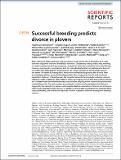Successful breeding predicts divorce in plovers
Abstract
When individuals breed more than once, parents are faced with the choice of whether to re-mate with their old partner or divorce and select a new mate. Evolutionary theory predicts that, following successful reproduction with a given partner, that partner should be retained for future reproduction. However, recent work in a polygamous bird, has instead indicated that successful parents divorced more often than failed breeders (Halimubieke et al. in Ecol Evol 9:10734–10745, 2019), because one parent can benefit by mating with a new partner and reproducing shortly after divorce. Here we investigate whether successful breeding predicts divorce using data from 14 well-monitored populations of plovers (Charadrius spp.). We show that successful nesting leads to divorce, whereas nest failure leads to retention of the mate for follow-up breeding. Plovers that divorced their partners and simultaneously deserted their broods produced more offspring within a season than parents that retained their mate. Our work provides a counterpoint to theoretical expectations that divorce is triggered by low reproductive success, and supports adaptive explanations of divorce as a strategy to improve individual reproductive success. In addition, we show that temperature may modulate these costs and benefits, and contribute to dynamic variation in patterns of divorce across plover breeding systems.
Citation
Halimubieke , N , Kupán , K , Valdebenito , J O , Kubelka , V , Carmona-Isunza , M C , Burgas , D , Catlin , D , St Clair , J J H , Cohen , J , Figuerola , J , Yasué , M , Johnson , M , Mencarelli , M , Cruz-López , M , Stantial , M , Weston , M A , Lloyd , P , Que , P , Montalvo , T , Bansal , U , McDonald , G C , Liu , Y , Kosztolányi , A & Székely , T 2020 , ' Successful breeding predicts divorce in plovers ' , Scientific Reports , vol. 10 , 15576 . https://doi.org/10.1038/s41598-020-72521-6
Publication
Scientific Reports
Status
Peer reviewed
ISSN
2045-2322Type
Journal article
Collections
Items in the St Andrews Research Repository are protected by copyright, with all rights reserved, unless otherwise indicated.

